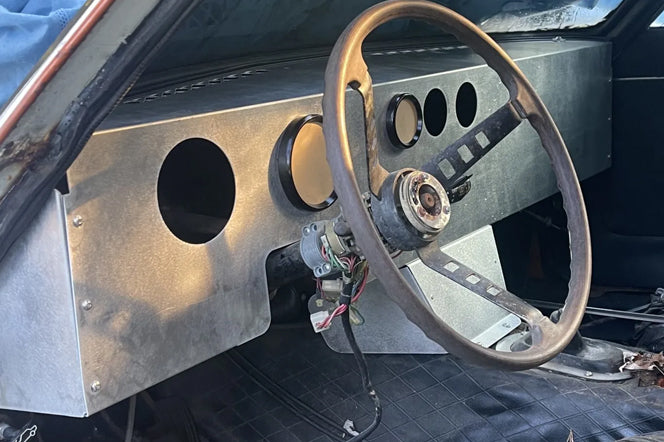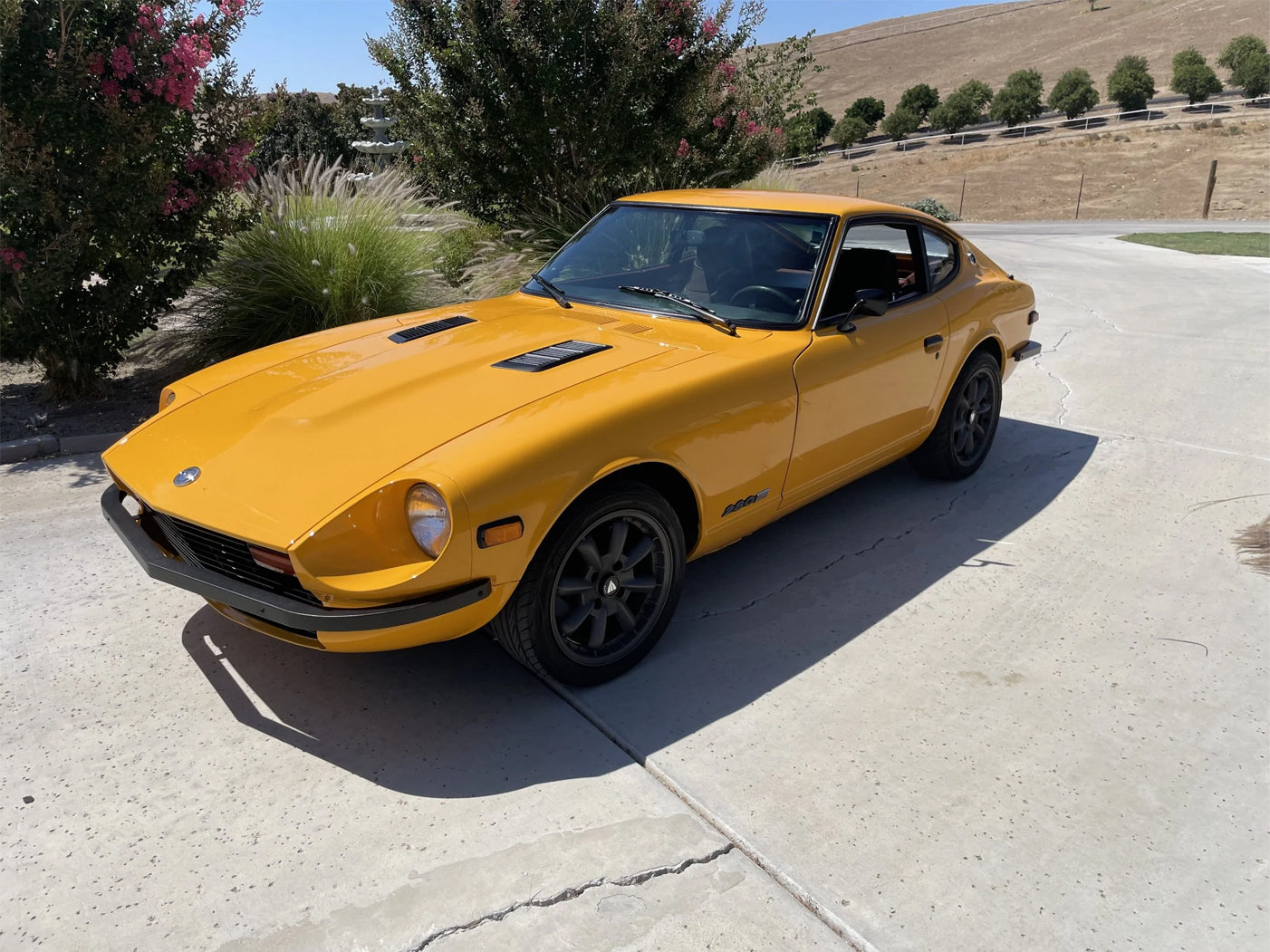When people talk about modernizing the Datsun Z series models like the 240Z, 260Z, and 280Z through upgrades, one of the things that usually comes up is a racing fuel cell.
Fuel cells function pretty much like the OEM gas tanks, but they reduce the common issue of fuel sloshing around in race cars and some road vehicles. That's not all - they also offer an extra layer of protection in case of an accident, and they have baffles, which is a must-have for EFI upgrades.
This article is going to dig into how such an upgrade could really make your beloved Datsun Z even better. It doesn't matter if you're into pristine vintage pieces or if you're a racing enthusiast - I put together this post to educate and inspire.
Let's talk about this!
Disclaimer: This article is authored by a member of the Skillard community and reflects their personal views, not necessarily those of Skillard. We welcome your feedback and corrections in the comments to help us continually improve this content.
Table of Contents
Increase Safety by Installing a Fuel Cell
Datsun Z cars come loaded with fuel cells made out of kevlar, steel, or aluminum. This type of construction has its own benefits; it makes these cars tougher, especially for high-speed accidents. Think of the caps on these cells - they don't have vents and even have rollover valves. So if your car flips (scary thought) I know these useful features help stop any fuel from leaking. Then there's the inside of these cells. They have a flexible bladder that can handle tons of stress, unlike your plain old fuel tanks.
Fuel cells usually get placed inside the car instead of at the back. Why is this cool? Because it keeps you safer from fires or explosions in the unlikely event that you get rear-ended. So, these fuel cells aren't something to take lightly. They're a big safety measure both on and off the track, and it's a big upgrade for older cars that might not have all those want-to-safety features modern cars do.

Photo credit: B is for Build
Fuel cells hide a little-known feature: foam baffling. This thing has a serious job. It's there to soak up fuel and stop it from moving around in ways it shouldn't. This greatly lowers the chance of dangerous fumes or a sudden explosion. It's a lifesaver in the truest sense of the word!
The bottom line is slotting a fuel cell into a Datsun Z car does a heck of a lot more than modernize its tech. Safety gets a big boost. Spirited driving conditions are no problem with a fuel cell equipped. It's like having a strong safety barricade against fuel leaks and explosions, which makes your ride safer. So why not make your peace of mind a priority and make your driving a whole lot less stressful?
If you're into track days, I bet you're concerned about FIA FT3, FT3.5, and FT5 certifications. I honestly can't overstate the importance of these certifications. They set the rules for material durability and fuel cell structure - things you can't do without on the racetrack. And, who wouldn't want a steady fuel supply no matter how crazy the driving conditions get? When possible, pick products that meet these rigorous safety standards.
And let me remind you: safety isn't a one-time deal. Racing fuel cells have an expiration date, usually every five years. You have to keep up with your checkups and recertifications.
Why You Should Upgrade Your Fuel System Too
Time to switch to an Electronic Fuel Injection (EFI) system? Well, you'll need to think about adding a fuel cell. You'll soon find out that your current non-baffled tank isn't useful anymore. Fuel cells keep fuel from sloshing around on turns, and make sure your engine always has enough to drink. But don't think that's the end of the story. You also have to beef up your fuel delivery network to match this new system.

A quick and smooth fuel flow is a must-have for high-performance engines. Right here is where racing fuel cells can upgrade your fuel game. And sure, pressure and flow rate might ask for some changes - things like changing fuel lines or adjusting filters and regulators. And if you ignore these changes? You're looking at average, at best, performance or even serious engine damage. Not a pleasant thought, right?
Here's something else - racing fuel cells can also handle ethanol/E85 or methanol. Your old fuel system can't handle those. Also, they need more quantity to give the same energy as gasoline, so your fuel pump will need a little boost.
But keeping up with high safety standards is important in the high-end fuel system game. Racing fuel cells come with foam to cut back on fuel sloshing, which means lower explosion risks and safer rides. So, improving the fuel system also brings in improved safety.
You can't forget the law, though. Your area might have rules about messing with fuel systems, so when you switch to a racing fuel cell, you have to follow those rules. Know these laws, and driving modified beasts on highways won't be a problem.
Why is a Fuel Cell Really Important for Racing Compliance?
Do you find a fuel safety cell pointless for a casual track day in your Datsun Z car? Well, it's kind of like a helmet or a seatbelt - they might seem like an extra headache at first, but you're happy they're there to protect you when you need it. Its job is to lower the chances of any nasty fuel accidents and keep the fire away. Track-day accidents can happen, and when you're taking turns at high speeds with other drivers, you don't want your stock fuel tank getting rear-ended.
The decision to get a fuel cell is driven by what the track day organizations lay down as ground rules. Every group, like the Sports Car Club of America (SCCA), has its own set of safety requirements for various events. It's not a hard and fast rule that a safety fuel cell is needed at every event. A bit of homework on your racing class rules or a quick chat with the series leader is going to give you a clear picture of whether an FIA-approved fuel cell is a must-have.

But when it comes to competitive racing circuits, there are usually rules in place that require safety fuel cells to meet certain measures.
Does using an aluminum tank sound like a good idea to you - especially if you're not worried about rankings? Remember, loads of people think safety fuel cells are the better option thanks to their extra protection. In my opinion, putting one in your Datsun Z car is a pretty smart move if you have both track days and competitive races in your future. A safety fuel cell isn't a tough thing to add in, and it really works to reduce risks.
Eliminate Rust Issues
Ok, here's one more benefit of fuel cells for Z cars that you might not be aware of - they resist rust.
That's right - rust. It's a constant headache for those poor Datsun Z owners who end up having to clean, seal, or even completely replace their rust-ravaged gas tanks.

The type of material you make fuel cells from, like polyethylene, aluminum, or powder-covered steel, plays an important part. These can take on the nasty effects of dampness much better than the old metal in the stock tank. Datsun Z cars tend to have iron-made gas tanks, and they get rusted out very easily.
It looks like an increasing number of Datsun Z owners battling with the whole rusting deal are picking fuel cells as their favorite solution. They are a piece of cake to maintain, and they are pretty darn good at avoiding rust.
For Datsun Z owners fighting the endless rust wars, that's pretty useful to know. It's one less thing to worry about.
Are Fuel Cells Practical?
Think about things like your driving habits and what you'll be using the car for. The cool thing about fuel cells is that they're pretty good at turning chemical energy into electric energy, which makes them a green option! You'll definitely feel good if you're big on sustainability.
But there's a flip side - installing fuel cells in a car isn't cheap! They're pricey, and that's a pretty big hurdle. And don't even get me started on the upkeep - you need to throw in money and effort to keep these high-tech systems humming along.
Another tough spot has to do with how you fill up. Gas stations are everywhere, but how do you fill up a fuel cell at a gas station? Most Datsun Z car owners pop the hatch and fill it in the trunk. Your old gas tank door may not be useful anymore.
But, some owners will path their gas tank door directly to their new fuel tank inside their car, which is a pretty sweet upgrade. This way, you can fill your fuel cell with the same fuel door you've always used, and you don't have to pop the hatch every time. You get the best of both worlds.

This is an extra cost, though; it takes more time and labor to set up something like that, but it definitely makes it more practical.
It depends on where you're using your car the most - the track or the road. If it's mostly a car for around town, it's a good idea to path it to your fuel door to make it easier to refill your tank. If it's a race car, it probably doesn't matter as much. It's personal preference.
How Much Do Fuel Cells Cost?
Datsun Z fuel cells have a lot of price options, which change with the size, what they're made from, and other features. Take an Aeromotive replacement fuel cell as an example. It has a 15-gallon capacity and is made from naturally finished aluminum, and it'll cost you close to $700.

Photo credit: Aeromotive
Jaz Products, on the other hand, has an affordable 16-gallon street rod fuel cell made of polyethylene plastic, and it costs about $150.
Let's talk about Radium. They have a spare tire fuel cell installation kit. You can use it with a bunch of different Datsun Z models - they are pretty slick, but they'll set you back around $900-1000, not like the mounting hardware.
But check this out - a 5-gallon JEGS drop sump drag race fuel cell that you can get your hands on for only $135. Want more storage? Think about the 20-gallon Aeromotive replacement, which will set you back about $750.
Then comes Schultz Racing. They have their Ultimate SFI 28.3 fuel cell. It has 17 gallons of capacity but sits right up there in price of nearly $1,700. That's one of the higher-end models, but it's better suited for around town since a little 5-gallon drag racing tank won't get you far.

And remember, Fuel Safe. They have spare tire fuel cells for Datsun Z, with prices ranging from $700 to $1,000 based on capacity and specifications.
You have to remember - prices change! They can go up or down depending on the retailer, where you live, and when you want to buy. And here's something I think is really important: always check that the fuel cell you pick is right for the exact model of your Datsun Z and fits with the rules for how you want to use it.
Is It Worth It?
You have to know a few things before trying to put a fuel cell into a Datsun Z. You need to think about how safe it is, if you can modify it to fit your needs, how much it's going to make your car perform better, how hard it's going to be to install, how it's going to function, and what it's going to do to the car's resale value.
When it comes to safety - fuel cells cut the chance of gas leaks. That's great for older cars. And because you can squish them into the trunk - they don't take up too much space. That alone helps your car perform better since it gets the fuel around more efficiently.
But, and this is a big but, you have to think about the cash you're going to drop on this. Is it really worth all the money to fit your ride with a fuel cell? Remember, putting in a cell isn't something you can do with your eyes shut - you might need someone who knows what they're doing. And if you're just heading to the grocery store in your ride, do you really need the kind of fuel cell they put in high-end race cars? How much a fuel cell will increase the resale value of your car is anyone's guess - it all depends on what people think of such modifications.
So why put a fuel cell in your Datsun Z? You might be race-driving your car, giving it a makeover, or it might be a daily driver that is track-capable. If so, a fuel cell could well be a great option.

And when it comes to a modern engine - one that works with fuel injection instead of a carburetor - grabbing a fuel cell becomes a no-brainer, in my opinion. If you are converting to EFI, just go for it and don't second guess. You can't beat the baffled design, added safety, rust prevention, and easy add-ons like return fuel lines. Totally worth it.
If you choose to start improving your Datsun Z car, working with Skillard might be a good idea. We do a great job of making these cars look and run better if I do say so myself, and we make custom parts for models like the 240Z, 260Z, and 280Z, just to mention a few.
Check out our products and see why we're a favorite among Datsun owners!





